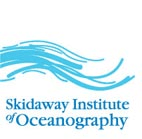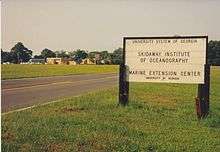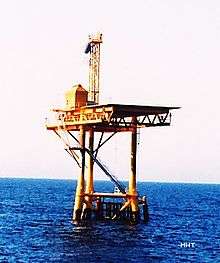Skidaway Institute of Oceanography
 | |
| Type | Independent Research Unit |
|---|---|
| Established | 1968 |
| Location |
Skidaway Island, Georgia, United States 31°59′19″N 81°01′16″W / 31.988548°N 81.021223°WCoordinates: 31°59′19″N 81°01′16″W / 31.988548°N 81.021223°W |
| Campus | 700 acres (2.8 km2), coastal setting |
| Affiliations | University of Georgia |
| Website | www.skio.uga.edu |
The Skidaway Institute of Oceanography (SkIO) is an internationally renowned marine science research institute located on the northern end of Skidaway Island near Savannah, Georgia, USA.[1] Founded in 1968, it is now a research unit of the University of Georgia.[2] It does not grant degrees, but its faculty serve as adjuncts to universities, and as mentors and advisors for visiting students and interns. SkIO faculty also frequently collaborate with marine scientists of other institutes both nationally and internationally. In 2012, It was announced that SkIO would be put under the management of the University of Georgia[3] as part of an effort to streamline the University System of Georgia, the realignment with the University of Georgia being completed in July 2013.
History
pre-SkIO
Skidaway Island was originally a hunting and ceremonial ground of the Timucua Indians. European settlement of the island was successful between 1754 and 1771, and included John Milledge (the father of John Milledge), who established a plantation on the northern end. He named it "Modena," presumably after the Italian city for its famed production of silk. Silk was an early industry of the European settlers of coastal Georgia. The Modena Plantation grew corn, cotton, oranges and mulberry trees, and kept sheep, cattle, hogs and horses. It survived as a plantation into the 1840s, until John Milledge III sold it in 1843. The name "Modena" is still used to refer to the northern part of the island.
After the American Civil War (1861–1865), many of the plantations on the island were unable to continue without slave labor, and their owners gradually sold them to wealthy northerners, who mostly held them on speculation. Much of the island reverted to wilderness and was used mainly for hunting, trapping, fishing and lumber for several decades. The Modena Plantation changed hands sixteen more times after the war. In 1927 the property became a private hunting preserve for Ralph H. Isham, best known for purchasing a collection of James Boswell's private papers from Baron Talbot of Malahide and passing them to Yale University.
Mr. Isham sold the property in 1934 to Robert C. Roebling (great-grandson of John Augustus Roebling). The Roebling family (Robert, Dorothy, and five children) established a farm for Black Angus cattle while living on their 176-foot (54 m) schooner, the Black Douglas, which provided all of the power needed by the farm until it was sold in 1941 to the United States Fish and Wildlife Service. The cattle farm was very successful for the next twenty years, until it came to an end in 1954 due to post-WWII economic pressures. Many of the buildings from the farm are still standing and in use by SkIO, most notably the seven-sided barn with its compass rose mosaic at the center.
Another successful European settler of the mid-18th century was Henry Yonge, who had a plantation located just southeast of Modena, called Orangedale. In 1877 it came into the ownership of the Benedictine Order. The Benedictines tried to establish a monastery and Catholic school for the newly freed former slaves on the island, but were unsuccessful. They abandoned their efforts in 1889. The "Priest tract," as the property had come to be called, became one of many acquired by a partnership of Thomas Bourke Floyd, James Boog Floyd, and A. Goden Guerard Jr. Thomas Floyd eventually assumed ownership of the entire middle portion of the island, until economic hardship forced a transfer to C&S Bank in 1924. The Union Camp Corporation purchased it from the bank in 1941.
The Founding of SkIO

In 1966, the Georgia Science and Technology Commission of the Georgia General Assembly proposed the establishment of an oceanographic research center on Skidaway Island. The thought at the time was to foster economic growth in coastal Georgia by attracting secondary industries of oceanography, in much the same way that secondary industries of space exploration had arisen around NASA.
Dorothy Roebling donated approximately 790 acres (3.2 km2) of the Modena property to the State of Georgia for this purpose in 1967, including 384 acres (1.6 km2) of high land, all of the buildings and farm workers, and both of their docks on the Skidaway River at the western side of the island. In addition, Union Camp donated 635 acres (2.6 km2) of the Orangedale property, including 300 acres (1.2 km2) of high land with access to the Wilmington River at the eastern side of the island; this portion of the campus is now called Priest Landing.
With the land donations, the Georgia General Assembly created the "Ocean Science Center of the Atlantic (OSCA)" in 1967. The Skidaway Institute of Oceanography was officially created in January 1968 with Thomas Jackson (formerly of Georgia Tech) as director, two co-directors, a secretary, and several former workers inherited from the Roebling farm. Its first faculty member, Herbert L. Windom, began work in July 1968. President Richard Nixon and Governor Lester Maddox dedicated the first building of the program in 1970. Governor Jimmy Carter dissolved OSCA in 1972, at which point SkIO became an independent research unit in the University System of Georgia.
SkIO has had four directors during its existence: Thomas Jackson (1967–1970), David Menzel (1970–1993), Herbert L. Windom (1994–2001), and James G. Sanders (2002–2016). Clark R. Alexander is serving currently as Interim Executive Director.
The Skidaway Marine Science Campus
The institute operates on a 684-acre (2.8 km2) campus at 31°59′19″N 81°1′16″W / 31.98861°N 81.02111°W (31.9885476, -81.0212228)[4] surrounded by another 600 acres (2.4 km2) of salt marsh.[5] It has fifteen faculty with research interests ranging from nutrients and pollutants of the salt marshes and estuaries, to the movements of water masses between the coast and Gulf Stream, to the ecology of plankton and microbes of the open ocean. Much of the institute's research since its inception has focused on the southeastern U.S. continental shelf, the influences of land, open ocean, and atmosphere on the continental shelf, and other continental shelf environments worldwide.
Several other institutions share the 684-acre (2.8 km2) campus with SkIO including:
UGA Marine Extension Service
The University of Georgia Marine Extension Service (UGA MAREX) consists of several educational outreach facilities in the state of Georgia, including one on the Skidaway Marine Science Campus. The Marine Education Center and Aquarium (MECA) operates a small public saltwater aquarium of local marine fish and invertebrates, which is visited by 18,000 schoolchildren per year. There is also a small research facility for shellfish aquaculture.
Gray's Reef
The campus hosts the administering offices for NOAA's Gray's Reef National Marine Sanctuary, which is one of thirteen marine sanctuaries in the United States. It consists of 17 square nautical miles (58 km2; 23 sq mi) of a nearshore live-bottom rock reef, 17 nautical miles (31 km; 20 mi) off the coast of Sapelo Island, Georgia.
GSU Applied Coastal Research Lab
Dr. Clark Alexander of SkIO is the director of Georgia Southern University's Applied Coastal Research Laboratory (ACRL), which studies sedimentary processes of the coastal zone of Georgia, such as groundwater hydrology and shoreline erosion.
CIRE Lab
The CIRE program ("A Collaboration to Integrate Research and Education in Marine and Environmental Science and Biotechnology") of Savannah State University (SSU) collaborates with SkIO to operate a teaching laboratory on the campus. It provides hands-on research experience to undergraduate marine science students from SSU.
Georgia Tech Chemical Ecology Lab
Dr. Mark Hay of Georgia Tech has a laboratory facility at Priest Landing for studies in chemical ecology. Research focuses on the ability of marine fauna to detect predators, prey, competitors, and compatriots by smell, at varying levels of water turbulence.
Georgia Aquarium
The Georgia Aquarium has a specimen collection facility at Priest Landing.
Georgia DNR
The Georgia Department of Natural Resources Historic Preservation Division operates the Coastal Underwater Archaeology Field Station on campus. The field station manages, surveys, and protects state-owned underwater and shoreline archaeological sites on navigable inland and coastal waterways extending three miles (5 km) offshore. The station provides archaeological assistance to local, state, and federal agencies as well as the general public by offering information, support, educational opportunities, and technical guidance regarding Georgia’s underwater cultural resources and maritime heritage.
Research Vessels and Facilities
SkIO operates the R/V Savannah, a 92-foot (28 m) research vessel. Unlike its predecessor, the 72-foot (22 m) R/V Blue Fin (1970–2001) which had the hull of a fishing trawler and was originally a yacht named Princess Anne, the Savannah was specifically designed for marine research by the scientists who use it. It has a full-time crew of four and has been in operation since 2001.
In addition to the two docks originally from the Roebling farm and a third dock later constructed on the Skidaway River, a 300-foot (90 m) dock was constructed at Priest Landing to provide low-tide access for large research and other seagoing vessels from the Wilmington River. It was completed in 1972.
Significant Research Projects
CEPEX
In the 1970s, SkIO, in conjunction with the University of British Columbia and the Dept. of Fisheries for Scotland, initiated the Controlled Ecosystem Pollution Experiment (CEPEX), which studied the responses of pelagic marine organisms when exposed to low, chronic levels of various pollutants. The studies were conducted in the open ocean, and the ecosystems were controlled by capturing water of various depths in large plastic enclosures.[6]
JGOFS
During the 1990s, SkIO was a participant in the Joint Global Ocean Flux Study (JGOFS), which was an international effort of over twenty nations to study the ocean carbon cycle on a global scale.[7] It included numerous research cruises in all of the oceans of the world, with many projects studying the biology and organic geochemistry of organic matter as it cycles in the water column and eventually settles on the seafloor.
SABSOON

The South Atlantic Bight Synoptic Offshore Observational Network (SABSOON) is an offshore monitoring project begun in 1998, which collects data on a number of parameters about the ocean off the coast of the southeastern U.S., such as temperature, salinity, density, light levels, chlorophyll, dissolved organic matter, and velocity of currents. Such information is useful for tracking the movements of water masses offshore. The project also feeds realtime information on atmospheric conditions (temperature, humidity, barometric pressure, precipitation, dew point, etc.) to the U.S. National Weather Service, and provides water conditions (wind, wave height, etc.) for fishermen and recreational boaters.
Footnotes and References
- ↑ "Skidaway Institute of Oceanography". Retrieved 2007-06-02.
- ↑ "Skidaway Institute of Oceanography". Retrieved 2007-06-02.
- ↑ "Skidaway Institute to become part of UGA". OnlineAthens. Retrieved 12 December 2012.
- ↑ "Geographic Names Information System". United States Geological Survey. Retrieved 2008-01-31.
- ↑ "Geographic Names Information System Feature Detail Report". U.S. Department of the Interior (U.S. Geological Survey). Retrieved 2007-08-28.
- ↑ "CEPEX". Retrieved 2007-07-25.
- ↑ "JGOFS". Retrieved 2007-07-25.
- New Georgia Encyclopedia
- Skidaway Island history
- Skidaway Island Comprehensive History
- Roebling family history
- Untitled. Wainwright and Eudora Roebling. Prepared by "Historic Services, Inc." for the Ocean Science Center of the Atlantic. Private Printing of 40 copies by D.A. Byck and Company, Savannah, GA. December 1972.
- An Historical Sketch of Skidaway Island. John F. McGowan. July 1983. 13 pp.
- A Short History of Skidaway Island. V.E. Kelly. 3rd ed. 2003. 162 pp.
